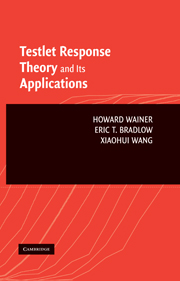Book contents
- Frontmatter
- Contents
- Preface
- PART I INTRODUCTION TO TESTLETS
- 1 Introduction
- 2 True score theory
- 3 Item response theory
- 4 What's a testlet and why do we need them?
- 5 The origins of testlet response theory – three alternatives
- 6 Fitting testlets with polytomous IRT models
- PART II BAYESIAN TESTLET RESPONSE THEORY
- PART III TWO APPLICATIONS AND A TUTORIAL
- Glossary of terms
- Epilogue
- Bibliography
- Author Index
- Subject Index
4 - What's a testlet and why do we need them?
Published online by Cambridge University Press: 08 January 2010
- Frontmatter
- Contents
- Preface
- PART I INTRODUCTION TO TESTLETS
- 1 Introduction
- 2 True score theory
- 3 Item response theory
- 4 What's a testlet and why do we need them?
- 5 The origins of testlet response theory – three alternatives
- 6 Fitting testlets with polytomous IRT models
- PART II BAYESIAN TESTLET RESPONSE THEORY
- PART III TWO APPLICATIONS AND A TUTORIAL
- Glossary of terms
- Epilogue
- Bibliography
- Author Index
- Subject Index
Summary
Introduction
In 1987, Wainer and Kiely proposed a name for a packet of test items that are administered together; they called such an aggregation a “testlet.” Testlets had been in existence for a long time prior to 1987, albeit without this euphonious appellation. They had typically been used to boost testing efficiency in situations that examined an individual's ability to understand some sort of stimulus, for example, a reading passage, an information graph, a musical passage, or a table of numbers. In such situations, a substantial amount of examinee time is spent in processing the stimulus, and it was found to be wasteful of that effort to ask just one question about it. Consequently, large stimuli were typically paired with a set of questions. Experience helped to guide the number of questions that were used to form the testlet. It is easy to understand that if, for example, we were to ask some questions about a 250-word-reading passage, we would find that as we wrote questions, it would get increasingly difficult to ask about something new. Thus, we would find that eventually the law of diminishing returns would set in and a new question would not be generating enough independent information about the examinee's ability to justify asking it. In more technical language, we might say that the within-testlet dependence among items limits the information that is available from that 250-word passage.
Thus, for the first century or so of its existence, testlets were used simply as a method of constructing tests that contained large stimuli in an efficient way. This all changed in the 1980s when computerized adaptive testing (CAT) became technically and economically possible.
- Type
- Chapter
- Information
- Testlet Response Theory and Its Applications , pp. 44 - 59Publisher: Cambridge University PressPrint publication year: 2007
- 1
- Cited by



